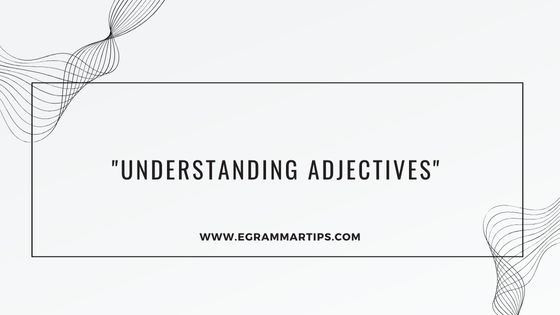
1. What Are Adjectives?
An adjective is a word that describes or gives more information about a noun (person, place, thing) or pronoun (he, she, they). In simple terms, adjectives are words that tell us what kind, which one, how many, or how much about a noun.
Example:
The big dog is barking. (Big describes the size of the dog.)
2. Types of Adjectives:
a. Descriptive Adjectives
These adjectives give information about the qualities or characteristics of a noun. They tell us what kind of noun.
Examples:
- The red car (describes the car’s color).
- A beautiful garden (describes the garden’s appearance).
b. Quantitative Adjectives
These adjectives describe the quantity of something. They answer how much or how many.
Examples:
- He drank some water (how much water).
- I saw three birds (how many birds).
c. Demonstrative Adjectives
These adjectives point out specific things and answer which one or which ones. The most common are this, that, these, and those.
Examples:
- This book is mine (which book? This one).
- Those apples are fresh (which apples? Those).
d. Possessive Adjectives
These adjectives show ownership or possession. They answer whose.
- Examples:
- That is my house (whose house? My house).
- Her cat is playful (whose cat? Her cat).
e. Interrogative Adjectives
These adjectives are used in questions and are often followed by nouns. They include which, what, and whose.
Examples:
- Which book do you prefer?
- Whose bag is this?
f. Indefinite Adjectives
These refer to non-specific items and include words like some, any, many, few, several, all, each.
Examples:
- Some people left early.
- Few students knew the answer.
3. Degrees of Comparison of Adjectives
Adjectives can express degrees of quality or quantity, and this is done using positive, comparative, and superlative forms.
a. Positive Degree
The adjective in its normal form, used to describe a single thing without making a comparison.
Example: The cat is cute (no comparison made).
b. Comparative Degree
Used to compare two things. Most adjectives form the comparative by adding -er or by using more before the adjective.
Examples:
- The cat is cuter than the dog (compares two animals).
- This car is more expensive than that one (using more because “expensive” is a longer adjective).
c. Superlative Degree
Used to compare three or more things and show the highest degree of the quality. Superlatives are usually formed by adding -est or using most before the adjective.
Examples:
- The cat is the cutest (compares more than two animals).
- This is the most expensive car in the showroom.
Irregular Comparisons:
Some adjectives don’t follow regular patterns for forming comparatives and superlatives.
Examples:
Good → Better → Best.
Bad → Worse → Worst.
4. Order of Adjectives
When using multiple adjectives to describe a single noun, they follow a specific order in English. The general order is:
1. Opinion (e.g., beautiful, horrible)
2. Size (e.g., big, small)
3. Age (e.g., new, old)
4. Shape (e.g., round, square)
5. Color (e.g., red, blue)
6. Origin (e.g., Italian, American)
7. Material (e.g., wooden, metal)
8. Purpose (e.g., sleeping bag, running shoes)
Example: A beautiful big old round Italian wooden table.
5. Position of Adjectives
Adjectives can appear in two different positions in a sentence:
a. Attributive Adjectives (Before the noun)
Most adjectives are placed before the noun they modify.Example: The hungry dog (adjective before the noun dog).
b. Predicative Adjectives (After a linking verb)
Some adjectives appear after a linking verb (like is, seems, becomes) and describe the subject of the sentence.
Example:
The dog is hungry (adjective after the verb is and describes the subject dog).
6. Limiting Adjectives
Limiting adjectives restrict or specify a noun rather than describe it. They include numbers, articles (a, an, the), demonstratives (this, that), and possessives (my, his).
Examples:
- Five students arrived early (restricts how many students).
- Her book is on the table (shows ownership).
7. Participial Adjectives
These are adjectives formed from verbs and can take two forms:
a. Present Participles (ending in -ing):
Describe an ongoing action.
Example: The crying baby kept everyone awake.
b. Past Participles (ending in -ed or -en):
Describe something that has been acted upon.
Example: The broken window was quickly repaired.
8. Compound Adjectives
Compound adjectives are two or more words connected by a hyphen that function as a single adjective before a noun.
Examples:
A well-known artist.
A three-hour meeting.
9. Adjectives vs. Adverbs
Adjectives and adverbs are often confused. Adjectives describe nouns and pronouns, while adverbs describe verbs, adjectives, or other adverbs.
Adjective Example: He is a quick runner (describes runner).
Adverb Example: He runs quickly (describes runs).
10. Common Errors with Adjectives
1. Double Comparatives/Superlatives:
Don’t use more and -er together (e.g., more better is wrong).
2. Adjective Agreement:
In some languages, adjectives must agree in number and gender with the noun. In English, adjectives don’t change form, so no need to add -s or -es.
I hope you enjoyed the lesson !